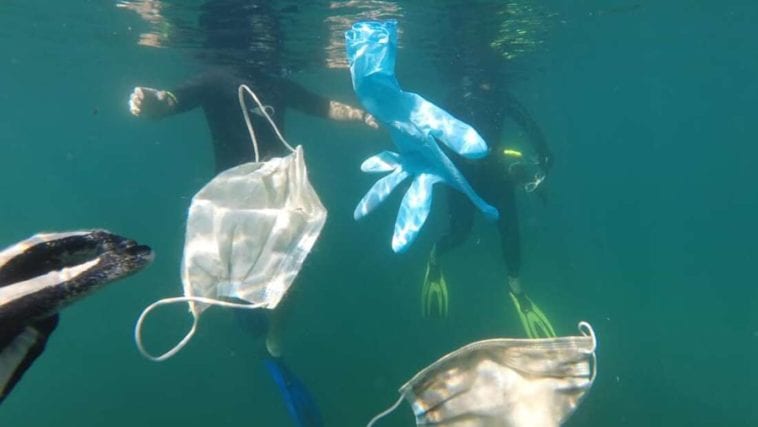In this uncertain world, especially these days there is this one virus that changed a lot of things for all people. The usual lifestyle of humans has changed and not only one country experience this but all of the people in all countries of the whole planet. Before, when we met our friends or colleagues outside we tend to give hugs or kisses but when Covid-19 spread all over the world, things like giving hugs and kisses or even shaking of hands have also changed. When we met our friends somewhere, we can only send our greetings and love far away from them.
Also, as much as we want to smile whenever we met people who know us, there is a barrier for them to see your smile and it is the mask, it is blocking your sweet smile. Even if we don’t want it we have to accept that it is for our own good, this policy is implemented for us to safe from the virus that may pass from one person to another.
However, while protecting our health from pathogens and bacteria, it is a misconception that plastic is more sterile and safer to use. That is a misconception that leads to dangerous pollution in our environment. Face masks now contaminate and degrade the waters, land, air of the whole world, particularly since most sold and used are disposables.
This is the medical waste crisis wherein millions of face masks and other contaminated wastes come from hospitals, health institutions, and even households. A waste crisis that endangers everything from human health to environmental integrity.
Why are face masks important?
Prior to the pandemic, face masks were used by people who have allergies to specks of dust and smoke and it is also used in the hospitals especially by doctors and nurses. But, during the COVID-19 pandemic, we are required by the government and health organizations to use face masks to protect ourselves from COVID-19, since the said virus is an airborne disease. They are used to filter the air that we breathe in and the air that we breathe out. Using them can prevent the virus from coming in into our bodies or spreading it to someone else.
If people are going to communicate with one another without putting on their face masks, people in the entire world would possibly be infected by the virus and if that happens there will be so many people that might lose their lives. In addition to that, if that happens we could no longer understand what tomorrow brings us.
Types of Face Masks and their effectiveness

Face masks are used to prevent us from different respiratory infections. They filter the air that we breathe in and breathe out, but there are different face masks with different effectiveness. Is your face mask effective enough to protect you from bacteria and viruses?
Cloth Mask (Reusable)
A cloth mask protects others from the germs breathed out by the user of the mask. Hence, the wearer prevents and stops other people to inhale germs. Wearing this kind of mask enables you to prevent inhaling germs coming from the air.
These are cloth masks with filter pockets.
Procedural masks
These work the opposite of cloth masks. Here, the person who wears the mask is protected against the germs coming from the air. Wearing this kind of mask enables you to prevent inhaling germs coming from the air.
Bandanna
This is a triangular or square piece of cloth mask. To use this kind of face mask, the user should tie the bandana over his mouth and nose. This prevents dust and other airborne particles from getting inhaled by the user.
Cone-style Mask
Similar to the bandanna is a cone-style mask. This face mask is molded to cover the mouth and nose of the user. According to medical research, this kind of face mask is less effective because it does not filter much air, but it is more effective than a bandana.
N-95 Mask
An N-95 mask is the most effective mask. It gives the highest level of protection to the person who wears it. It gives the highest level of protection from germs coming from the air. This is what frontline workers are required to use as they work closely with COVID patients.
Surgical Masks
This is the most common of all face masks. This mask is used to protect the user from inhaling the germs found in droplets in the air.
Face masks have different efficiencies but they have the same function and it is to protect the user and others from viruses and airborne germs. Just choose the mask that works best for your living situation. As brilliant as face masks can be in protection, you also need to dispose of them properly lest you contribute to the waste crisis that intoxicates almost the world over.
Medical Waste and its types
Medical wastes are wastes from the hospitals, centers, and other facilities that offer treatment and diagnosis. These are products that are used to cure or to get patients’ samples like blood, urine, and saliva and materials that are used by the doctor or nurses to protect themselves. These are dangerous because they contain toxic materials, especially when the medical equipment was used by or on a sick person. This runs the risk of transmission of diseases and infections.
- Syringes – these are usually used to get blood or to inject vaccines and other medicines to the patients. Some patients might have different diseases that can be transferred to other people if not disposed of in a safe way.
- Surgical masks and surgical gloves – are also used in the hospital by the nurses, doctors, and other staff of the hospital. These medical items are also used by the patients of the hospital especially to those patients who have diseases in the respiratory system that can be transferred to other people.
- Hair cups – these are also used in hospitals especially in operating rooms. The medical team uses this to protect their hair from falling while they are performing their operations.
These medical items are thrown away after they’ve been used. These items cannot be recycled and reused because it is a high risk that people might get infected by unknown diseases by these medical wastes. That is why it is really important that medical waste management should be strictly implemented to avoid getting infected by various infectious diseases and to keep everyone safe.
Face masks have different efficiencies but they have the same function and it is to protect the user and others from viruses and airborne germs. Just choose the mask that works best for your living situation. As brilliant as face masks can be in protection, you also need to dispose of them properly lest you contribute to the waste crisis that intoxicates almost the world over.
Dangers in Medical Waste
Medical waste is very dangerous especially to those countries that have poor hygiene and a high population. Medical facilities like hospital clinic and other places that offer treatments and diagnosis that has medical waste disposal are places that should be prohibited to the people especially to the area where they dispose their medical waste. Preventing people from going to this place helps them to avoid acquiring fatal diseases.
The use of face masks helps us to prevent catching different respiratory diseases, but it also causes problems on land and at sea. Nowadays, we wear masks to protect us from respiratory diseases like Corona Virus, but after using the disposable mask, we discard it and this may be a risk of spreading the virus to the garbage collectors and other public members who are exposed to the discarded disposable masks.
Also, those people that don’t care about the environment at all throw away their facemasks anywhere. It’s risky for homeless children who would think that it is okay to make fun of the mask that was thrown away.
We all know that the virus survives on a disposable plastic disposable mask for seven days and this is very dangerous to our health. Due to improper disposal of face masks and other medical waste such as syringes, needles, and drips, there is a danger of toxic substances leaching into waters, land, and residential areas.
Medical Waste and its Toll on the Environment
When it comes to adhering to the health protocols or performing tests for medical purposes. Inevitably, hospitals, nursing homes, medical research centers, clinics, and medical shops would produce biomedical wastes. Those may cause health risks as it may release pathogens and toxic pollutants into our environment. Also, when landfilled happens it may contaminate water if it will not be constructed properly.
Javid Manzoor and Manoj Sharma, the authors of “Impact of Biomedical Waste on Environment and Human Health” in Environmental Claims Journal published in 2019, stated that the issue of biomedical waste identification, handling, and disposal needs to have a heightened review so that better management practices and protocols can be established. Additionally, with the increasing population and the growth of the medical sector worldwide, such medical products generate significantly great pollution to water, soil, and air.
According to Ken Fullerton, a sustainable development consultant, if such wastes are not incinerated and end up in regular landfill sites and garbage dumps, toxins from the medical wastes is detrimental to human health. Moreover, we are faced by a dilemma in the context of incineration, this is because products that contain heavy metals or materials with high metal content (in particular lead, mercury and cadmium) can also lead to the spread of toxic metals in the environment, according to the World Health Organization in 2018.
According to WHO statistics, medical waste consists of 85% general, non-hazardous waste and 15% hazardous material ( infectious, toxic, or radioactive).
In a scientific study conducted by Al Raisi, Sulaiman, Suliman, & Abdallah in 2014 highlighted that the improper disposal of biomedical waste may cause negative impact on the water quality as different pollutants may leach out from the waste dumping sites into the ground water. They assessed and found that heavy metals in leachate were exceeding the drinking water standards. In terms of soil quality, different pollutants from medical wastes may get mixed with the soil and may change the chemistry and biology of the soil ecosystem.
Auta and Morenikeji (2013) confirmed in their study that soil samples from the bottom ashes of incinerators and municipal dumping sites are contaminated by heavy metals. In terms of air pollution, Lekwot et al. (2012) found that hospital waste incinerations emit dioxin and cause mercury pollution. The ash is equipped with toxic substances like heavy metals, dioxins, and furans. Such pollutants are detrimental to the health of nearby residents or even medical staff.
Such studies mentioned supports the statement of Megan Chamberlain –a Content and Digital Solutions Specialist, who says that Improper segregation of biomedical waste and different medical waste streams from the point of origin can trigger a domino-like effect on the environment that incurs dangers to people, animals, or soil and water sources. Hence, immediate action from the communities is needed to mitigate the growing problem.
Solutions to the Medical Waste Crisis
We need to respond in a multi-pronged approach to solve the medical waste crisis. This includes individual actions and institutional coordinated efforts.
Ken Fullerton addressed three general strategies that can be done simultaneously to combat this crisis. (1) Efforts by the health profession itself
(2) Awareness of proper medical waste disposal techniques and the dangers of incorrect disposal brought by health professionals, policy-makers, and other relevant stakeholders
(3) Safe and environmentally-friendly waste management options.
Nonetheless, these are all components of the requirement needed to create societal changes that play a key to provide a solution to the medical waste crisis.
According to the Centers for Disease Control and Prevention, healthcare facilities must regularly throw away medical wastes to avoid accumulation. This includes storing them in labelled, leak-proof, puncture-resistant containers under conditions that minimize or prevent foul odors. Where you store them should also be well ventilated and be pest-free.
After storing the medical waste well, medical professionals need to treat them, especially microbiologic wastes, to prevent the spread of infections. In particular, microbiologic wastes and sharps pose the greatest risk for injuries. To make the process safer for everyone, the personnel who will handle this waste should take the following steps:
- Dilute the discharged materials with water
- Deactivate pathogens resulting from exposure to cleaning chemicals, disinfectants, and other chemicals in raw sewage; and
- Check and ensure the effectiveness of sewage treatment in inactivating any residual blood borne pathogens that reach the treatment facility.
Secondly, awareness about proper waste disposal and waste management to the public is crucial. Individual solutions include the proper waste segregation of personal protective equipment used by the household. This simple act can aid in the proper recycling of materials to be used for other items.
Waste management company TerraCycle has Zero Waste Boxes to collect and recycle PPE, face masks, and disposable gloves, explained Julia Chevalier, PR Manager at TerraCycle Europe. The old materials are melted into pellets that can be used by third parties to manufacture outdoor furniture, decking, and storage containers. Alongside with this is the underlying yet critical message for all users and consumers of medical equipment, it is to practice proper disposal of such items.
How can we protect ourselves and the environment at the same time?
According to the article by Abigail Saltmarsh, keeping ourselves safe should not be at the cost of the planet. Organizations are developing new solutions to reduce the negative impact on the environment.
In this pandemic era, innovation plays a big role in hitting two birds with one stone, that is, protecting ourselves and the environment at the same time. Organizations have taken the next step further by being resourceful and sustainable in making personal protective equipment.
Saltmarsh mentioned in the article that a French start-up, called Plaxtil, offers a solution for surgical, fabric and FFP2 masks and is currently conducting a pilot in Châtellerault, France, where it has recycled almost 100,000 masks. The co-founder of Plaxtil, Olivier Civil stated that crushed and grinded masks (without the metal bar), are transformed into mask fasteners, door openers, protective visors, etc. The grinded material is also passed through a UV tunnel to be completely decontaminated in depth. This project is inspired by the fact that a mask thrown into nature will take nearly 500 years to disappear, and the best way to protect ourselves and the environment is finding a way how to mitigate such pollutants.
Secondly, organic, biodegradable materials could provide solutions. At Australia’s Queensland University of Technology (QUT), a product made from waste plant material, such as sugar cane bagasse and other agricultural waste, has been developed. The original aim was to develop biodegradable, anti-pollution masks. The same mechanism can also be used in the masks for COVID-19 PPE.
The EssentialTech Center of the Swiss Federal Institute of Technology in Lausanne (EPFL), Switzerland, researchers have also finalized the HelloMask, which is made from a polymer composition, currently in the process of being patented, which is 99% organic, biomass derivative. This specific mask is transparent and breathable, as well as biodegradable and recyclable. It is designed to reveal facial expressions, as well as to filter out viruses and bacteria.
Lastly, being actively involved in making a beneficial impact to the world by reducing biomedical wastes, Megan Chamberlain stated in her article that being in partnership with Daniels Health provides sustainable healthcare waste management solutions that minimize environmental burdens, reduce the volume of medical waste going to landfills, and reducing sharps injury and costs related to their treatment. In conclusion, the urgency to combat this crisis involves being aware of what is happening such as seeing the bigger picture, as well as combining all group and individual efforts. In the end, this will all be for the betterment of the world and humanity as a whole.
Do not forget to take good care of our environment. As mother earth gets abused, we, humans, will be the one that will suffer and especially the generations next to us.




